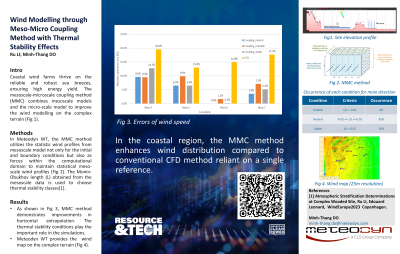Back

Wind Resource Modelling in Complex Terrain through Meso-micro Coupling Method in Considering Thermal Stability Effects
Tuesday, October 1, 2024
5:00 PM – 6:00 PM MST
Location: Regency D


Minh-Thang DO, PhD
Technical Manager of Renewable Energy
Meteodyn
Bourne, Massachusetts
Poster Presenter(s)
Presentation Description: Coastal wind farms thrive on the reliable and robust sea breezes, ensuring high energy yield. Their strategic location, near populated areas and boasting expansive open spaces, makes them ideal for wind energy projects.
In this situation, attention should increasingly focus on the impacts of both microscale topography and mesoscale regional climate conditions, the thermal stability effect. In this study, the mesoscale-microscale coupling method is proposed. It combines mesoscale models which capture the climate conditions and introduce them in the micro-scale model, with microscale model that focus on the terrain complexity to improve the wind resource modelling at the coastal area.
The statistical wind profiles from meso-scale model are used not only as the initial and boundary conditions but also as forces in the computational domain to maintain the statistical meso-scale wind profiles in meso-scale zone. The Monin-Obukhov length obtained from the mesoscale data is used to choose thermal stability classes.
Here, we investigate a coastal site equipped with several meteorological masts using various methodologies: the Computational Fluid Dynamics (CFD) modelling approach, the mesoscale-microscale coupling approach, and the multi mesoscale modelling approach. The results indicate that the mesoscale simulation tends to underestimate the wind in this coastal region. Both Coupling method and Multi meso method demonstrate improvements in horizontal extrapolation between masts.
In the absence of met mast measurements, incorporating mesoscale data in the CFD modelling using the mesoscale-microscale coupling approach can help reduce errors, compared to relying on a single reference point.
In this situation, attention should increasingly focus on the impacts of both microscale topography and mesoscale regional climate conditions, the thermal stability effect. In this study, the mesoscale-microscale coupling method is proposed. It combines mesoscale models which capture the climate conditions and introduce them in the micro-scale model, with microscale model that focus on the terrain complexity to improve the wind resource modelling at the coastal area.
The statistical wind profiles from meso-scale model are used not only as the initial and boundary conditions but also as forces in the computational domain to maintain the statistical meso-scale wind profiles in meso-scale zone. The Monin-Obukhov length obtained from the mesoscale data is used to choose thermal stability classes.
Here, we investigate a coastal site equipped with several meteorological masts using various methodologies: the Computational Fluid Dynamics (CFD) modelling approach, the mesoscale-microscale coupling approach, and the multi mesoscale modelling approach. The results indicate that the mesoscale simulation tends to underestimate the wind in this coastal region. Both Coupling method and Multi meso method demonstrate improvements in horizontal extrapolation between masts.
In the absence of met mast measurements, incorporating mesoscale data in the CFD modelling using the mesoscale-microscale coupling approach can help reduce errors, compared to relying on a single reference point.
